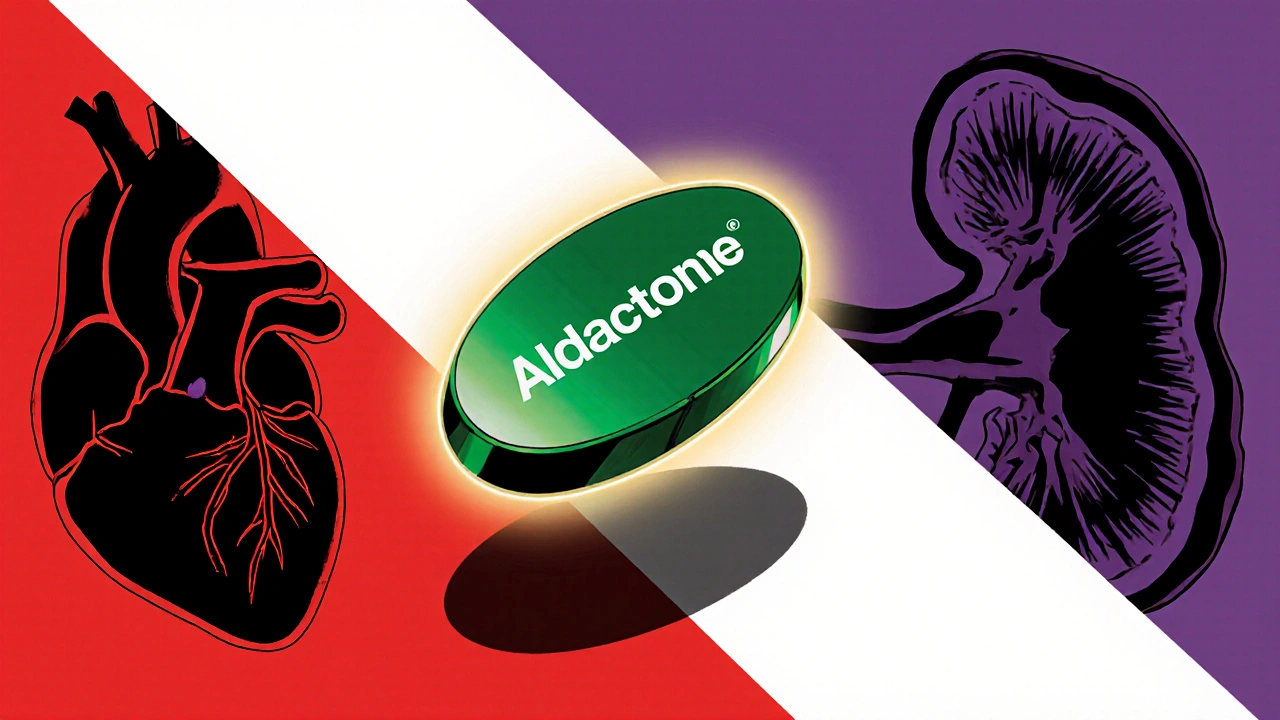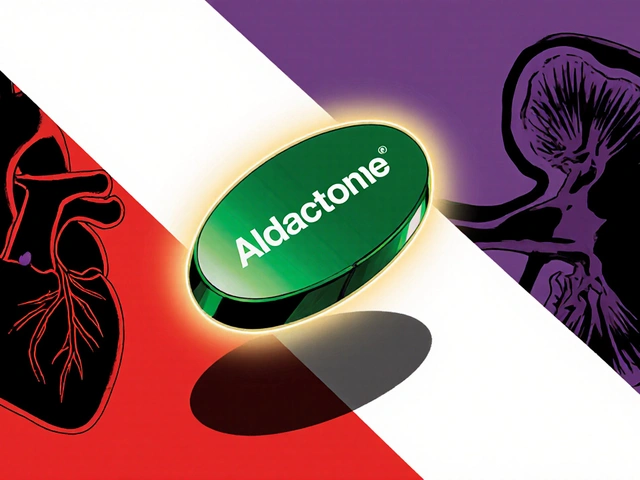Diuretic and Aldosterone Antagonist Decision Guide
Find Your Best Option
Answer a few questions about your medical situation to find which diuretic or aldosterone antagonist might work best for you.
When you think of Spironolactone, the first image that pops up is often a green tablet labeled Aldactone, a drug that’s been used for decades to treat high blood pressure, heart‑failure swelling, and even acne. But the market is crowded with other diuretics and aldosterone blockers that promise similar results with different side‑effect profiles, dosing schedules, or costs. This guide walks you through the most common alternatives, lining up each drug’s mechanism, typical uses, pros, and cons so you can decide which fits your health goals best.
Key Takeaways
- Spironolactone is a potassium‑sparing aldosterone antagonist best for resistant hypertension, heart‑failure edema, and hormonal acne.
- Eplerenone offers a cleaner side‑effect profile but is pricier and less potent for acne.
- Loop diuretics like furosemide work fast for severe fluid overload but can cause significant electrolyte loss.
- Thiazide‑type agents (hydrochlorothiazide) are cheap and effective for mild hypertension but are not potassium‑sparing.
- Combination potassium‑sparing agents (amiloride, triamterene) are useful adjuncts but rarely replace spironolactone as monotherapy.
What is Spironolactone?
Spironolactone is a synthetic steroid that blocks the action of aldosterone at the distal tubule of the kidney, promoting sodium excretion while retaining potassium. It was first approved in the United States in 1960 and marketed under the brand name Aldactone. Its dual role as a diuretic and an anti‑androgen makes it unique among heart‑failure and dermatology drugs.
How Spironolactone Works
The drug binds to mineralocorticoid receptors, preventing aldosterone from signaling the kidneys to reabsorb sodium and water. This results in a modest increase in urine output, reduced blood volume, and consequently lower blood pressure. In the skin, spironolactone blocks androgen receptors, decreasing sebum production and improving acne.
Top Alternatives: An Overview
Below are the most frequently prescribed alternatives, grouped by class.
- Eplerenone - a selective aldosterone antagonist with fewer endocrine side effects.
- Furosemide - a loop diuretic for rapid fluid removal.
- Hydrochlorothiazide - a thiazide diuretic commonly used for primary hypertension.
- Amiloride - a potassium‑sparring diuretic often paired with thiazides.
- Triamterene - another potassium‑conserving agent, useful in combination therapy.
- Losartan - an angiotensin‑II receptor blocker (ARB) that can be combined with diuretics for hypertension.
- Lisinopril - an ACE inhibitor, often a first‑line choice for blood‑pressure control.

Side‑Effect Profile Comparison
Understanding side effects is crucial when swapping drugs. Spironolactone’s anti‑androgen activity can cause gynecomastia in men and menstrual irregularities in women. The table below aligns each alternative’s most common adverse events.
| Drug | Primary Indication | Mechanism | Typical Dose | Key Side Effects | Approx. Monthly Cost (USD) |
|---|---|---|---|---|---|
| Spironolactone | Hypertension, heart‑failure, acne | Aldosterone antagonist | 25‑100 mg daily | Hyperkalemia, gynecomastia, menstrual changes | ~$15 |
| Eplerenone | Heart‑failure, post‑MI | Selective aldosterone antagonist | 25‑50 mg daily | Hyperkalemia (less endocrine), dizziness | ~$80 |
| Furosemide | Acute pulmonary edema, severe HF | Loop diuretic (Na‑K‑2Cl transporter inhibition) | 20‑80 mg oral, up to 600 mg IV | Hypokalemia, ototoxicity, dehydration | ~$5 |
| Hydrochlorothiazide | Essential hypertension | Thiazide diuretic (NaCl reabsorption inhibition) | 12.5‑50 mg daily | Hypokalemia, hyperuricemia, photosensitivity | ~$4 |
| Amiloride | Hypertension, edema (adjunct) | ENaC blocker (potassium‑sparing) | 5‑10 mg daily | Hyperkalemia, nausea | ~$7 |
| Triamterene | Hypertension, edema (adjunct) | ENaC blocker (potassium‑sparing) | 50‑100 mg daily | Hyperkalemia, kidney stones | ~$6 |
| Losartan | Hypertension, diabetic nephropathy | Angiotensin‑II receptor blocker | 50‑100 mg daily | Dizziness, hyperkalemia (when combined with K‑sparing diuretics) | ~$12 |
| Lisinopril | Hypertension, heart‑failure | ACE inhibitor (reduces angiotensin‑II) | 10‑40 mg daily | Cough, angioedema, hyperkalemia | ~$10 |
When to Choose Spironolactone Over the Rest
If you need a drug that tackles both fluid overload and hormonal acne, spironolactone remains the gold standard. Its potency in antagonizing aldosterone makes it especially useful for patients with resistant hypertension-those whose blood pressure stays high despite two other antihypertensives. The anti‑androgen effect also gives dermatologists a double‑hit tool for adult women struggling with stubborn breakouts.
When an Alternative Might Be Better
Consider the following scenarios:
- Eplerenone: Ideal for heart‑failure patients who experience gynecomastia on spironolactone, as it lacks significant anti‑androgen activity.
- Furosemide: The go‑to for rapid diuresis in acute pulmonary edema or severe renal insufficiency where a strong loop effect is needed.
- Hydrochlorothiazide: Best for cost‑sensitive individuals with uncomplicated hypertension and no potassium concerns.
- Amiloride or Triamterene: Useful when you already use a thiazide and want to preserve potassium without adding spironolactone’s hormonal side effects.
- Losartan or Lisinopril: Preferred when the therapeutic goal is to block the RAAS cascade rather than merely promote natriuresis; they also provide proven cardiovascular protection.

Practical Switching Guide
- Check baseline labs: serum potassium, creatinine, and eGFR. Spironolactone raises potassium; alternatives like furosemide lower it.
- Identify the primary therapeutic need (blood‑pressure control, edema, acne, renal protection).
- Select the alternative that matches that need while minimizing overlapping side effects.
- Adjust dose gradually. For example, if moving from spironolactone 50 mg to eplerenone, start at 25 mg and monitor potassium weekly for two weeks.
- Re‑check labs after 2-4 weeks, then every 3 months thereafter.
Cost‑Effectiveness Snapshot
Cost often dictates prescription patterns. Generic spironolactone sits at roughly $15 per month, while eplerenone’s price can exceed $80. Loop diuretics like furosemide are cheap but may incur additional monitoring costs due to electrolyte shifts. When budgeting, weigh drug price against the expense of managing side effects-frequent potassium labs, potential endocrinology referrals, or treating gynecomastia can add up.
Frequently Asked Questions
Can I take spironolactone and a thiazide diuretic together?
Yes. Combining a potassium‑sparing agent like spironolactone with a thiazide (e.g., hydrochlorothiazide) can balance electrolyte effects while providing stronger blood‑pressure reduction. Monitor potassium and blood pressure closely.
Why does spironolactone cause gynecomastia?
Spironolactone blocks androgen receptors and inhibits testosterone conversion, which can stimulate breast tissue growth in men. Switching to a more selective blocker like eplerenone reduces this risk.
Is furosemide safe for long‑term use?
Furosemide is effective for chronic heart‑failure management, but long‑term use requires regular monitoring of potassium, magnesium, and kidney function to avoid depletion and ototoxicity.
Can I replace spironolactone with amiloride for acne?
Amiloride does not have anti‑androgen effects, so it won’t improve acne. It’s useful only for its potassium‑sparing diuretic action.
What laboratory tests should I order before starting an aldosterone antagonist?
Baseline serum potassium, creatinine, eGFR, and a basic metabolic panel are essential. Repeat potassium after the first week, then at 1 month, and periodically thereafter.
Bottom Line
Spironolactone remains a versatile, low‑cost option for patients who need both diuresis and anti‑androgen benefits. However, its side‑effect profile pushes many clinicians toward newer, more selective agents like eplerenone, or toward completely different classes (loop, thiazide, or RAAS blockers) depending on the clinical picture. Use the side‑effect table, dosing guide, and FAQ above as a decision‑making toolkit-match the drug’s strengths to your patient’s primary need, keep labs in check, and you’ll avoid costly complications.




Eileen Peck
October 22, 2025 at 13:58Hey there! I get why the side‑effect table can feel a bit overwhelming – there’s a lot to juggle. If you’re mainly after the anti‑androgen benefit for acne, spironolactone really shines, despite the occasional typo‑ish confusion with dosing. Just keep an eye on potassium levels and have a quick chat with your doc every few weeks. Hope this helps you make a smoother decision!
Oliver Johnson
October 28, 2025 at 04:30Honestly, all these “newer” drugs are just marketing fluff. You can’t beat the raw power of spironolactone, even if it isn’t as fancy. Keep it simple, keep it cheap, keep it working.
Taylor Haven
November 2, 2025 at 20:01We live in an age where pharma giants silently steer our prescriptions, and spironolactone is a relic that the establishment tries to sideline. They push eplerenone as the "safer" option, yet the underlying agenda is to keep us dependent on patented drugs that line corporate pockets. The truth is, a cheap, decades‑old medication can do the job just as well, if not better, for many patients. It's an example of how the medical elite manipulates data to sow doubt about affordable generics. The anti‑androgen side effects are framed as disastrous, but most users experience them rarely and manage them simply. Meanwhile, they pump up the price of alternatives, turning a $15 a month drug into an $80 luxury. Every lab test you’re forced to take after switching is another revenue stream for labs and insurance. The narrative that spironolactone causes rampant gynecomastia is overblown; it’s a side effect that can be screened for and mitigated. By the way, the infamous "hydrated‑sodium balance" studies are heavily funded by the very companies that market newer diuretics. Think about how many lives are saved when a low‑cost, widely available drug stays on the market. The conspiratorial aspect is not just a wild theory; it’s backed by whistleblowers who have seen the behind‑the‑scenes lobbying. We must stay vigilant and demand transparency from both prescribers and regulators. If you’re skeptical, you should read the original 1960 trial reports – they’re public domain now. Let’s not allow the guise of "modern medicine" to erase the usefulness of tried‑and‑true treatments. Your health decisions deserve honesty, not a fabricated fear of side effects. In short, keep spironolactone in mind; it’s a tool the powers that be would love you to forget.
Sireesh Kumar
November 8, 2025 at 11:33Whoa, that was a marathon, Taylor! Let’s break it down: spironolactone’s potency in both diuresis and anti‑androgen action is indeed a unique combo. If you’re watching costs, the $15 monthly tag beats the pricey eplerenone by a mile. Just remember, labs are still needed for potassium checks; that’s non‑negotiable.
Vandermolen Willis
November 14, 2025 at 03:04Exactly, Sireesh! 💡 A bit of monitoring and you’re golden. 😊
Also, pairing with a thiazide can give you that extra pressure drop without breaking the bank.
Mary Keenan
November 19, 2025 at 18:36Spironolactone’s side effects are overhyped.
Kelly Brammer
November 25, 2025 at 10:08While the benefits are clear, clinicians must uphold the ethical duty to monitor potassium vigilantly. Neglecting this responsibility is simply unjustifiable.
Ben Collins
December 1, 2025 at 01:39Oh sure, because we all have endless time to sit through endless labs, right? If you love paperwork, go ahead-spend your weekend at the clinic. For the rest of us, a cheap, effective drug that doesn’t demand a PhD to manage is a blessing.
Denver Bright
December 6, 2025 at 17:11Honestly, Ben, I’ve seen too many folks dump spironolactone without checking kidney function. It’s not just a casual swap; it’s a medical decision that deserves respect.
Kelli Benedik
December 12, 2025 at 08:42Do you feel that? The drama of a cheap pill versus a pricey one is like watching a soap opera where the hero is a tiny green tablet! 🌈💊 It’s heartbreak when you think you’ve found the perfect fit, only to hear whispers of “maybe it’s not enough.” But then, like a plot twist, you discover that the low‑cost option actually keeps the skin clear and the heart happy. Let’s give the humble spironolactone its standing ovation! 🎭
cariletta jones
December 18, 2025 at 00:14Great overview! It’s reassuring to see clear options for different needs.
Kevin Hylant
December 23, 2025 at 12:58Keep monitoring potassium levels if you stay on spironolactone. This is essential for safety.